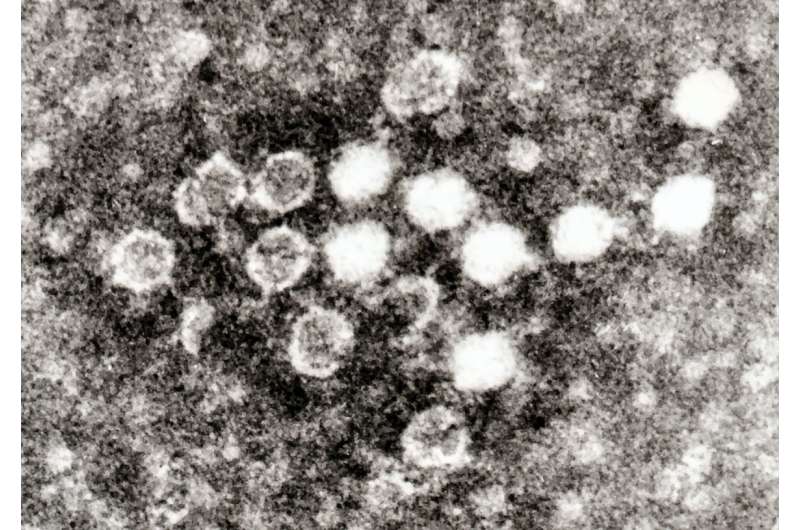July 13, 2018 report
Researchers isolate parvovirus from ancient human remains

Airborne and bloodborne human parvovirus B19 causes a number of illnesses, including the childhood rash known as fifth disease, chronic anemia in AIDS patients, arthritis in elderly people, aplastic crisis in people with bone marrow-related illness, and hydrops fetalis in pregnant women. A single-stranded DNA virus, it has no vaccine or cure, and treatment generally consists of managing symptoms until the immune system can suppress the virus.
Most viral genomic sequences available for research are no more than 50 years old. Access to older samples could provide researchers with detailed knowledge of extinct genetic diversity and viral phylodynamics. An international collaborative of researchers now reports their analysis of ancient human parvovirus samples taken from the dental and skeletal remains of 1,578 people who lived lived between 500 and 6,900 years ago. They have published their findings in the Proceedings of the National Academy of Sciences.
The researchers screened DNA sequencing data from the ancient remains of people from Eurasia, Southeast Asia and Greenland for traces of human parvovirus B19. Their results prove that it is possible to recover and sequence ancient single-stranded DNA sequences. It is unclear why parvovirus persists over such vast spans of time, but the researchers suggest that its DNA could be protected by the viral capsid, by self-annealing during preservation, or through other mechanisms.
Human parvovirus has three genotypes. From the 1,578 subjects, the researchers found 20 samples matching human parvovirus; eight were from genotype one, 12 were from genotype two, and none matched genotype three. This rules out previous suggestions that genotype one first emerged after World War II. The researchers note that the wide range of mammals that carry parvovirus-derived genomes suggest that the virus could be older than 12.6 thousand years.
Genotype two is believed to have been the result of a recombination of genotypes one and three. Based on the position of the ancient sequences, the researchers were able to date this event to about 5,000 to 6,800 years ago.
One of the most notable findings the researchers reported is that human parvovirus, which is known to have a rapid rate of evolution comparable to that of RNA viruses, actually evolves at a rate approximately an order of magnitude lower than previously believed.
Regarding the geographic distribution and spread of the virus, the researchers had limited data. They write, "On the basis of our data, it is possible to hypothesize a geographic separation between the ancient genotype one sequences, found in Central Asia, and ancient genotype two sequences, found in Europe and Greenland." They note, however, that this could be sampling bias attributable to the small number of positive samples.
They conclude by suggesting that future studies could increase the understanding of the evolutionary processes of pathogens and improve phylogenetic inference techniques.
More information: Ancient human parvovirus B19 in Eurasia reveals its long-term association with humans. Proceedings of the National Academy of Sciences; DOI: 10.1073/pnas.1804921115
Abstract
Human parvovirus B19 (B19V) is a ubiquitous human pathogen associated with a number of conditions, such as fifth disease in children and arthritis and arthralgias in adults. B19V is thought to evolve exceptionally rapidly among DNA viruses, with substitution rates previously estimated to be closer to those typical of RNA viruses. On the basis of genetic sequences up to ∼70 years of age, the most recent common ancestor of all B19V has been dated to the early 1800s, and it has been suggested that genotype 1, the most common B19V genotype, only started circulating in the 1960s. Here we present 10 genomes (63.9–99.7% genome coverage) of B19V from dental and skeletal remains of individuals who lived in Eurasia and Greenland from ∼0.5 to ∼6.9 thousand years ago (kya). In a phylogenetic analysis, five of the ancient B19V sequences fall within or basal to the modern genotype 1, and five fall basal to genotype 2, showing a long-term association of B19V with humans. The most recent common ancestor of all B19V is placed ∼12.6 kya, and we find a substitution rate that is an order of magnitude lower than inferred previously. Further, we are able to date the recombination event between genotypes 1 and 3 that formed genotype 2 to ∼5.0–6.8 kya. This study emphasizes the importance of ancient viral sequences for our understanding of virus evolution and phylogenetics.
Journal information: Proceedings of the National Academy of Sciences
© 2018 Phys.org




















